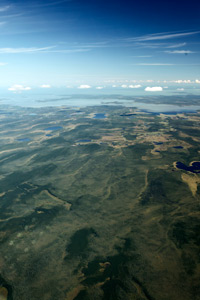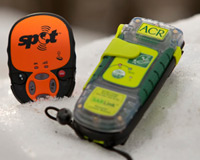
The arrival of spring means it may be time to enjoy a trip to Canada’s great outdoors. Our northern neighbor’s unspoiled wilderness, magnificent mountains, and scenic lakes beckon hikers, hunters, and fisherman each year. Canada is aviation-friendly and there’s no better way to see the country than by air. However, since much of Canada is wilderness area, Canadian Aviation Regulations require pilots to carry survival equipment for many flights. 
First, here are the exceptions to the rule. CAR 602.61 states that survival equipment is not required for:
- A balloon, a glider, a hang glider, a gyroplane or an ultra-light aeroplane;
- An aircraft that is operated within 25 nautical miles of the aerodrome of departure and that has the capability of radiocommunication with a surface-based radio station for the duration of the flight;
- A multi-engined aircraft that is operated south of 66o 30' north latitude in IFR flight within controlled airspace, or along designated air routes;
- An aircraft that is operated by an air operator, where the aircraft is equipped with equipment specified in the air operator's company operations manual, but not with the equipment required by subsection (1); or an aircraft that is operated in a geographical area where and at a time of year when the survival of the persons on board is not jeopardized.
If your flight over wilderness areas is not listed as an exception, you will need survival equipment that provides the means for:
Transport Canada offers the following information and table of recommended survival equipment:
A basic survival manual should be carried, appropriate to the area of flight.
Private pilots should obtain some training in certain aspects of survival if they have never spent time in the bush in winter or summer. Those planning to fly above the tree line should obtain more specialized training.
 Locating and saving people in aeronautical emergencies has been greatly improved by the changes implemented by the SARSAT/COSPAS members. Today the SARSAT/ COSPAS system provides global detection capability by satellite. The improvement in reliability of ELTs in conjunction with the global application SARSAT/COSPAS systems has greatly increased the chances of early detection and location of crash survivors. The carriage of food is no longer a critical item in survival and is left as a personal choice of the individual operator.
Locating and saving people in aeronautical emergencies has been greatly improved by the changes implemented by the SARSAT/COSPAS members. Today the SARSAT/ COSPAS system provides global detection capability by satellite. The improvement in reliability of ELTs in conjunction with the global application SARSAT/COSPAS systems has greatly increased the chances of early detection and location of crash survivors. The carriage of food is no longer a critical item in survival and is left as a personal choice of the individual operator.
|
Rule: Provide Shelter: must keep dry and out of wind to prevent death from hypothermia.
|
|
Geographic Area
|
Season
|
Equipment and other items
|
|
West Coast,
British Columbia
|
All seasons
|
Survival Equipment Suggestions: To provide protection from rain, sleet and sometimes snow; plus wind; and insulation from wet ground.
Reason: Hypothermia possible in all seasons if person becomes wet and unable to get out of the wind.
1. Tent
2. Tarpaulin 8’ x 8’ (could be nylon sheet) – ideally blaze orange colour
3. Saw – to make shelter from branches, but difficult in wet conditions to make shelter rain proof
4. Personal rain protection – could be as simple as a garbage bag
5. Space blankets (not to be used on sleeping bags – sweating will soak you in two hours) Use as tarpaulin or for short periods to warm up a person by wrapping around them.
6. Air inflated mattress or unicell foam pad
7. Branches piled 8” deep and dry; (needs evergreen trees and saw or axe plus experience) [(6 and 7 are for shelter from ground; cold ground sucks heat out of body) able to get out of wind]
8. Sewing Kit to repair clothing, etc.
|
|
Spring and Summer
|
9. To the above, add mosquito head nets and possibly tape for taping jacket wrists and pant bottoms for protection from insects.
|
|
Interior British Columbia – mountain country
|
Winter
|
Greatest protection required from wind and lower temperatures.
As for coast, plus sleeping bag (one for each 2 persons). Sleeping bags must be dried out each day or they become useless after 2 days. In a survival situation never have everyone asleep at the same time.
Most deaths from hypothermia occur well above the freezing temperature.
|
|
Prairies below timberline
|
All seasons
|
As above for BC Interior. Minimal protection needed during summer; temperature is normally high. Consider in fall and winter, lots of protection from rain, snow, etc. There is still a problem in these seasons from hypothermia.
|
|
Ontario to East Coast below timberline
|
All seasons except higher humidities can
be expected
|
As above for BC Interior.
Protect from wind in all seasons and any form of wetness.
|
|
Newfoundland
|
All seasons
|
As above for BC Interior.
Protection from wind and sea breeze which can be devastating.
|
|
North of tree line
|
Summer
|
As above for BC Interior.
Wind and insect protection are most important. Days are long. Lots of time to set up shelter.
|
|
Winter
|
Sleeping bag with wind protection paramount. Usually no fuel for wood fire to provide warmth.
|
^ Return to top ^
|
Rule: Means of making fire.
|
|
Geographic Area
|
Season
|
Equipment and other items
|
|
West Coast, British Columbia
|
All seasons
|
Making a fire on the West Coast of B.C. is very difficult on wet rainy days and especially in winter when cold weather cools fuel.
|
|
Remaining wooded areas of Canada
|
All seasons
|
As above except that starting and keeping fire going using trees branches shrubs, etc., is much easier.
|
|
Above treeline
|
All seasons
|
Need fuel tablets for heat and cooking if there is something to cook.
|
|
Applicable to all
|
All seasons
|
Suggested equipment:
1. Waterproof matches, e.g., matches in a waterproof container.
2. Candle for starting stubborn fire.
3. Fuel tablets
4. Saw, axe (if knowledgeable) and tools for obtaining dry or burnable material from nature.
All persons must understand the need to warm up fuel to get it burning. Training on how to start and keep a fire going is recommended. (This type of training is needed by many individuals.) Fire must be in association with shelter for warmth and protection.
|
^ Return to top ^
|
^ Return to top ^
Rule: Signaling
|
|
Geographic Area
|
Season
|
Equipment and other items
|
|
West Coast,
British Columbia
|
All seasons
|
Signaling is very difficult unless near a river, stream or treeless hillside (too many trees).
When the sun shines, the best means is a signal mirror (sometimes called a heliograph). It is effective over 22 miles – far beyond where you can see or hear an aircraft.
Fire and smoke are normally ignored by most fly-by aircraft; they are also hard to see.
The eight-foot by eight-foot orange panel can be seen well before any other signal except the mirror signal, and it does attract attention.
|
|
For all areas
of Canada
|
All seasons
|
Pyrotechnics
In the hands of a trained person, pyrotechnics can be very good. In the hands of a novice, they can reduce chances of survival.
Pencil pyrotechnics will not go above a 30-ft tree in winter (cold makes them useless).
For night signaling, a good strobe light can be seen on a clear night up to eight miles away. A flashlight is effective for about one-half mile.
One must use judgment to provide equipment in keeping with the forecast weather.
|
^ Return to top ^
|
Rule: Purified Water
|
|
Geographic Area
|
Season
|
Equipment and other items
|
|
For all areas
of Canada
|
All seasons
|
Canada possesses the purest water in the world; however, in some areas water can be contaminated by dead animals or for other reasons. We need some way of providing safe drinkable water.
Solution: Water purification tablets or other methods prescribed by a pharmacist.
If boiling water is the preferred method, you need a fire and a good container for boiling water (a billy kettle). If you do not have a suitable container, you cannot boil water.
Training is also needed in how to melt snow in a container over a fire.
|
If you would like information on the requirements for the pilot, passengers, and aircraft, please click here.
Of course, if you have questions, please call AOPA's Pilot Information Center, Monday through Friday, 8:30 a.m. to 6 p.m. Eastern Time, 800-USA-AOPA (872-2672).


Locating and saving people in aeronautical emergencies has been greatly improved by the changes implemented by the SARSAT/COSPAS members. Today the SARSAT/ COSPAS system provides global detection capability by satellite. The improvement in reliability of ELTs in conjunction with the global application SARSAT/COSPAS systems has greatly increased the chances of early detection and location of crash survivors. The carriage of food is no longer a critical item in survival and is left as a personal choice of the individual operator.



